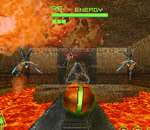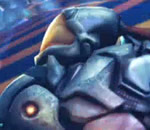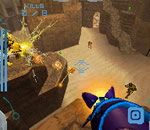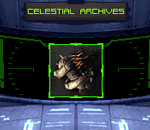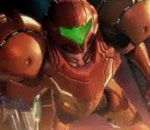Metroid Prime Hunters review
Metroid Prime Hunters is an unusual specimen. The title was first announced in 2004, but didn't see a release until 2006. Developed by Nintendo Software Technology (NST - based in Redmond, Washington), this first-person shooter was originally meant to take advantage of the wireless Nintendo DS multiplayer capabilities, and ended up delayed to allow the addition of Nintendo WFC support. While the final product's multiplayer side expanded on and surpassed the multiplayer experiment Retro Studios played with in Metroid Prime 2, the single player aspect is short-and-mostly-sweet.
The Metroid experience has always featured action, adventure, exploration and isolation. Trying to tie that unique world into a first-person shooter multiplayer frenzy was always going to be a tricky proposition, like trying to squeeze Samus' Morph Ball through a tiny square hole. But analogies aside - NST have built a solid Nintendo DS title, while not necessarily a completely solid Metroid title.
The first real challenge for both the developers and players alike would be the control system. How do you take the first-person style of Metroid Prime and adapt it to the touch-screen control system of the Nintendo DS? Unfortunately the end result might need special equipment to work properly.
The controls are partially customisable, but essentially the stylus is primarily used to aim your character. While that doesn't sound too bad at first, try picturing yourself supporting the weight of the DS in one hand while trying to aim frantically with the stylus in the other. You'll definitely need plenty of stamina for this exercise. Thankfully the use of a thumb stylus significantly improves the experience, allowing you to hold the DS with both hands and work the controls in a similar - and in some ways smoother - fashion to the dual-joystick nature of recent console first-person shooters. It's just a pity the game wasn't bundled with one.
The story itself is fairly straightforward, with Samus exploring a derelict star system devoid of its local inhabitants. The addition of rival bounty hunters was another risky venture, but even with six opponents hungry for whatever Samus is also searching for, NST have managed to evoke the feeling of isolation quite well. Giving each hunter their own origin story and motive was a great touch too. Metroid Prime Hunters took a risk with plenty of firsts for the series, another of which involved visiting multiple worlds instead of a single location. Even though you've got areas reminiscent of other locations visited in the Prime trilogy, the quiet and lonely atmosphere of each does well to fit into the series proper.
Graphically we've got a sharp and crisp 3D world for Samus to explore, and while the DS's output could never look as good as GameCube or Wii titles, NST have given us a good interpretation of what a Metroid title may have looked like on the Nintendo 64. The audio is surprisingly good too, with literally hundreds of sound effects crammed into that tiny cart. The music is fantastic and presents a number of remixed tunes from the main trilogy, but it fits the atmosphere perfectly and strives for a darker, claustrophobic tone that is an absolute joy to listen to.
To help compensate for the lack of graphical horsepower and for an extra treat that wouldn't have been possible on the N64, short pre-rendered cutscenes are riddled throughout the single-player adventure. The compression to fit on a DS cart has done it a disservice however, as these cutscenes are stunning pieces dripping with atmosphere (I don't really know why, but my favourite scenes are the simple shots of Samus' gunship arriving at and departing from the different worlds. It must be the jet-blackness of space behind the planets/satellites and that eerie musical overtone... oh yeah). Then there's those quiet ambient themes in her gunship... Samus herself is quite a sight too - be sure to finish the game fully to see one of her best Zero Suit representations.
While Hunters generally pulls the right strings, there are a few areas lacking in the Metroid formula. This time Samus begins the game with all of her suit upgrades from the start, with nothing new to add to the collection apart from offensive weaponry. Only new weapons and the regular ammo and energy tank expansions can be added to her arsenal. On the upside, each new weapon is based on the personality and technology of each rival hunter, but it's sad to see that all the regular upgrades we all know and love are missing in action.
The game is also fairly short compared to the main trilogy and follows a repetitious course of treasure-hunting and boss-conquering. Two types of bosses are recycled multiple times, but at least they each possess different offensive tactics. The escape sequences that follow every boss encounter are extremely odd, as you don't have an obvious reason to race back to your gunship; the planets/satellites certainly don't explode upon beating the timer, and all you receive is a cutscene of Samus departing said location (which is fantastic, ahh the ambience).
So the treasure-hunting and backtracking we're all used to isn't in the same league as the main Prime trilogy, nor even the classic trilogy. There isn't even a single Metroid to be found in the game (granted this one does take place in a completely uncharted area beyond known space). The instant-death areas are really frustrating too - whatever happened to Samus' magical grappling hook to pull her back out of bottomless voids?
It would appear that with the advent of casual gaming and the insane success of the Nintendo DS, NST have given the multiplayer side of the game top priority to attract the attention of more than just the core fanbase. The multiplayer itself works quite well, with plenty of options and all the hunters to choose from. If you're a fan of frantic first-person shooters like Unreal Tournament, this is all going to feel somewhat familiar, just with a Metroid skin. It's great to see the ability to play online fully featured, especially considering Nintendo's track record of neglecting online gaming in the past.
This now leaves us at the inevitable conclusion - some Metroid fans will be disappointed with Hunters' offerings, while others might be more forgiving (another analogy - back in the day I loved Zelda II's wacky departure from the Zelda series' traditional overhead-view). Essentially, Nintendo wanted to use the Metroid universe to build a competent and accessible first-person shooter that anyone could pick up and enjoy. While they've definitely catered for that expanded audience (despite the taxing control system), nailing the single-player aspect was always going to be an uphill battle.
What we have here is a fun-yet-simple diversion from Samus' usual Space Pirate/Phazon fighting days, with a lighter story and fewer items to find. But the ambience and atmosphere definitely has its own charm, and some of the firsts Hunters took a chance with have led to greater ventures, like Metroid Prime 3's multi-world layout and Metroid: Other M's gorgeous cutscenes. NST have performed admirably on the DS hardware and have given us a slimmed-down, portable Metroid Prime with its own ups and downs - not too shabby for a western team developing for a relatively new platform (at the time) and for one of Nintendo's deeply established franchises.
Written by Falcon Zero on 3 March 2010.













